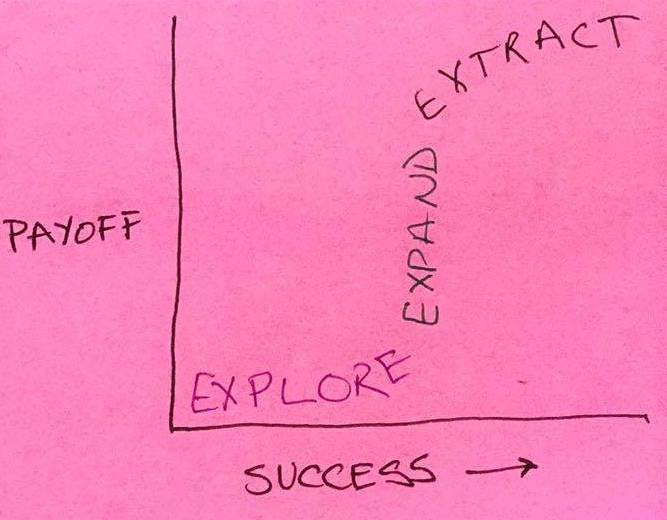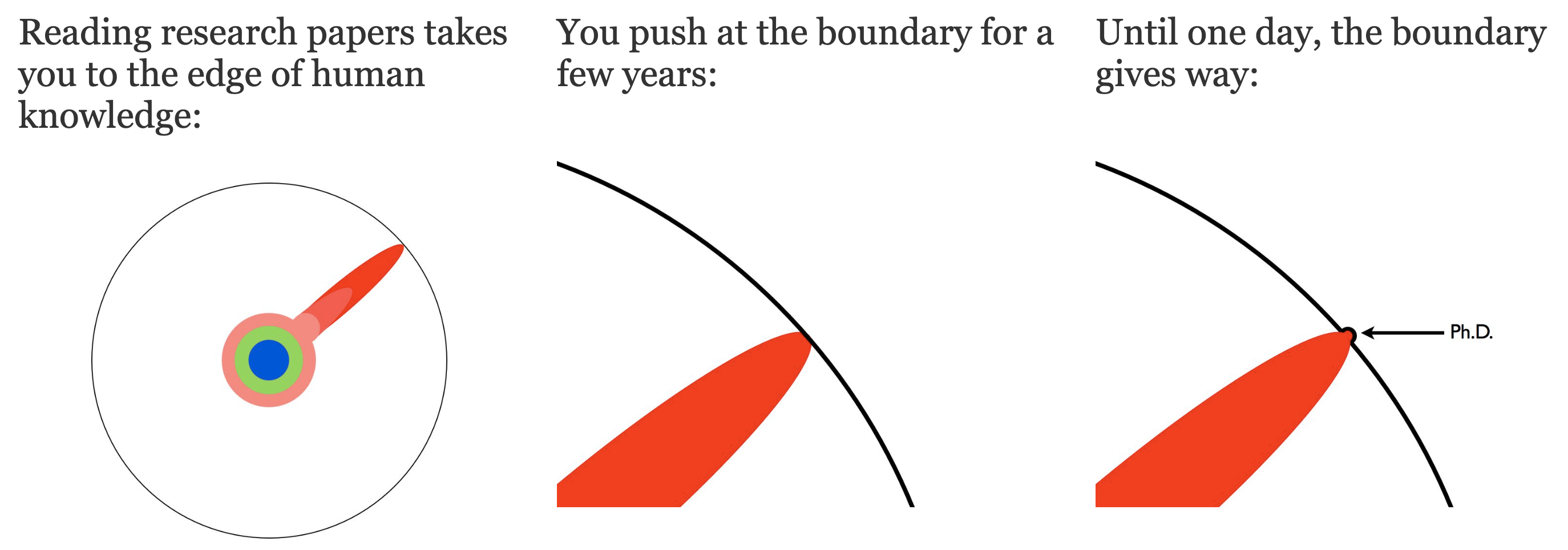Explore/Expand/Extract as Metaphor for Life
There’s an idea in software product development called “3X”, standing for Explore, Expand, and Extract. Each is supposed to represent a different stage of a software product’s journey.

This was originally proposed by Kent Beck, one of the original pioneers of the Agile Software Development movement. He has a lot of writing about how the model works and some of its consequences, but here’s my quick description of it.
First, a caveat
Be warned: the model is only neat and tidy if things are going right. Note that the X-axis in the graph above isn’t time, it’s success. Your own experience is likely to be a lot less linear than this model implies.
Got that? Then let’s dive in.
The phases
Explore
This is your typical “early-stage startup mode”. You want to go as broad as you can, and try to quickly validate whether you’re onto something.
Make hacky prototypes, fail fast, pivot often, experiment, and do things that don’t scale. Watch your users like a hawk, and talk to them as often as you can. You want to gather as much data and feedback as possible until you hit on something that’s actually useful to them.
Expand
You’ve now hit product-market fit. People are excited about it, and now you need to scale to match that growing demand.
If you remember Twitter in the late 2000s, this is when the “Fail Whale” would show up frequently, and they were desperately trying to make it show up less often. You need to make sure your servers are up and running, have a good incident review process so you can increase reliability when things do go wrong, and make your product something people can rely on.
Extract
Your product is now well-established. If you’re making professional software, it’s now an industry standard tool. If you’re developing for consumers, you’ve already expanded to a significant chunk of your target market.
At this point, you know your business well. Further expansion is slow and expensive, but returns on investment are clear, and you likely have well-defined runbooks for that expansion. Economies of scale and network effects are working in your favour, but it’s harder to make changes.
Consequences of this model
This is an interesting way of framing things, and thinking this way leads to a lot of useful conclusions. Here’s a few I’ve come up with.
Advice for one part of the curve might not apply to another
As a result, you should should always keep in mind the context where the advice-giver is typically coming from.
“We only take on projects that are clearly profitable” might make a lot of sense for a company in the Extract phase, but it’s a death sentence to a company in the Explore phase, because companies in the Explore phase have no idea what’s “clearly profitable” for them yet.
Or think about what it means to be “fast” or “agile”: in Explore, you want to remove barriers to experimentation and feedback gathering. In Expand, you want to quickly clear bottlenecks in your scaling and infrastructure. In Extract, you want to be able to quickly build out less-experimental but profitable projects. Trying to apply one phase’s definition of “fast” to another phase might lead you to make suboptimal decisions.
This curve might be leading you to a local maximum
Say you’ve climbed part or all of the way up the curve. What should you do next?
One option is to just keep climbing and see it through. The other option is to go back down the curve.
Why? Wouldn’t this be a step backwards?
Maybe. But you might currently be climbing towards a local maximum. Maybe you’ll get something that’s modestly successful when you could have something extremely successful.1

Source: Nicky Case’s Parable of the Hill Climber
There are multiple ways of going back down the curve:
-
You could sell your business or product and go start another.
-
Alternately, if your company is big enough, you can spin off a team to do more experimental work, while the rest of your business continues as usual. If done well, this lets you have the best of both worlds.
-
Or, if you have enough funds, you could wait for someone else to do the exploration for you, then buy them out.
This has some risk: you’ll likely have to pay a premium, you might get outbid, they might not be willing to sell, and you have to make sure you don’t accidentally destroy what made their product successful in the first place. Still, sometimes it works.
Of course, going back down the curve is always a risk. You might end up in a better place, but you could end up in a worse one than if you had just kept climbing. Some factors to consider include:
- How much higher do you think it’s possible to go?
- How badly do you want that bigger success?
- How competitive is your market?
- How much are you willing to risk in this experiment?
- How comfortable are you in working in the earlier stages of the curve?
That last point is important, so let’s talk about it in more detail.
You might be more comfortable working in one part of the curve
These stages all feel qualitatively different.
-
Explore is about opening yourself up to opportunity, and maximizing your chances of getting lucky. It means trying a lot of things out, having most of them fail, but occasionally finding a diamond in the rough.
-
Expand is about keeping the lights on and seeing how far you can take something. It means strapping yourself to a rocketship and trying to make sure it doesn’t blow up before it gets to its destination.
-
Extract is more about preserving and maintaining what you have. You already have something successful, now you have to defend it from threats and make prudent decisions.
This is why startup CEOs sometimes hand over the reins when the startup matures enough to become an established business. They’re more skilled and experienced with the lower parts of the curve, and they might need someone else to guide them through the higher parts.
The lower parts of the curve are characterized by having a lot to gain from risk. The higher parts are characterized by having a lot to lose from risk. Sometimes people can adapt to both kinds of environments, but attitudes towards risk and experimentation often differ between people and can influence how good it feels to be in any one of them.
Which one feels best to be involved in? That depends on the kind of person you are, or even sometimes what stage of life you’re in.
Wait, this sounds like it applies to more than just software development.
Yeah.
The more I started thinking about this model the more I started interpreting other areas of life through its lens.
Not everything transfers cleanly. For example, in a business, you can split off part of your workforce to work on a different part of the curve simultaneously. The best you can do in your personal life is to maybe partition your already-limited time and energy.
But the parallels are enough that it’s still worth looking at some examples.
Learning a new skill
Imagine you’re looking to pick up a new skill, like learning a new language or playing a musical instrument.
You’d likely benefit from taking a path that looks something like this:
-
Start by Exploring. Experiment and play around with the skill you’re trying to build, try different potential ways of learning it, and look for resources that might help.
The goal is to try and find a combination of learning methods that “click” with you, like I did when learning Mandarin Chinese.
-
After you’ve found that, Expand your skills by committing to the methods you’ve picked.
This is the part that arguably takes the most effort, so stick with it. Still, if you find you’re struggling or plateauing early, consider going back down the curve to explore more different learning methods.
-
Once you’ve developed the skill to a good-enough level, use it to Extract some value for your life.
Play music for your loved ones, or for an audience! Bond with native speakers of the language you learned! You put in all that effort, now enjoy it.
That’s not to say there’s no joy to be had from the earlier stages: it’s the journey and not just the destination, etc. etc. Nor does it mean you shouldn’t continue to grow your skills. But as you climb through the Extract phase, expect growth to be harder but (external) rewards to be greater.
There’s also a meta-level to this, where you might want to take some time to Explore which different skill you want to learn. Which one you pick depends on your goals: sometimes it’s just for fun or interest, sometimes there’s some external motivation, and sometimes it’s because you want to turn it into a job.
That latter bit is worth talking about on its own.
Career growth
The early stages of your career arguably stretch back to your childhood schooling. In elementary school, you’re given a broad base of knowledge that applies to just about anything you’ll do. In high school, you do some light specialization, but it’s usually relatively easy to change direction and switch courses around. These are arguably your “Explore” stage, where you can learn about different areas of study and try them all out.
After high school is where you start to specialize deeply. Let’s say that you go to university with the intention of getting into a professional field, like I did.
This marks the tail end of the “Explore” phase and a transition into the early part of “Expand”. You can still switch majors, but that ends up feeling like more of a step down the curve, since it can mean delaying graduation. This is especially true if it’s done late into a degree.
“Expand” is where you spend most of your time from university into your early-to-mid career. You’re learning and eventually working in a specialty that is (hopefully!) letting you grow your skills and reputation.
And “Extract” is when you’re a well-paid, senior expert. You can (hopefully!) rely on your accumulated experience and reputation to get yourself steady work.2
An aside on other career paths
The career progression I described above is an oversimplified sketch of the university-to-professional-career path I more or less took.
What about other career paths? I expect they share similarities, but end up needing more or less time in different phases.
Someone that did only high school—voluntarily or not—likely had very little time to spend in the “Explore” and “Expand” phases. The most successful folks in this situation manage to recapture some of that expansion via on-the-job learning, but not everyone gets that opportunity. I suspect there are a good number of folks here stuck in a local maximum.
Meanwhile, academia seems like it has an extremely long “Expand” phase. I’m not sure what you’d define as the “Extract” phase. Maybe the later parts of a tenure-track job?

Lightly-edited excerpt from Matt Might’s Illustrated Guide to a Ph.D.
Still, the tradeoff is that if you make it into the “Extract” phase you’re pretty much universally respected as a leader in your academic field. But it can be tricky or stressful to get there, and especially in fields with few tenure-track openings it can be easy to end up in a pretty bad local maximum.
Dating and romantic relationships
It’s almost uncomfortable how often advice for things like career and job hunting can also apply to dating.3
I think this is because of some general similarities: you have a “market” of eligible people, you’re looking to filter through them to find someone that you’re going to be spending a lot of time with for mutual benefit, personal fit is a big part of the criteria, both involve some pretty significant emotional investment, and the costs of making the wrong decision—and benefits of making the right one—can be huge.
Of course, the differences outweigh the similarities. You’re not going to show up to a first date with a résumé in hand,4 and marriages are (ideally) permanent, while pretty much no one keeps a job for life these days. But it’s still enough that we can still look at this through the 3X lens.
While you’re single, you start off with very little to lose, and a lot to gain. This is the part that people call “a numbers game”, where meeting new people and dating the ones you find interesting is the path to success.
Eventually, you find someone you like enough to start dating long-term, and this means you have to switch your approach towards deepening and strengthening that relationship.
And ideally, this leads to a level of trust and understanding deep enough that you decide you want to spend the rest of your lives together. The job of both of you is now to keep the relationship strong. You have a lot to lose if the two of you fail to do that. But if you succeed, it can be the single most valuable part of your life.
A lot of the lessons above still apply!
Advice for one part of the curve makes no sense for another. I doubt you can learn how to be a good husband by taking advice from pickup artists, for example. They focus too much on the far left side of the curve.5
You might be more comfortable being on one part of the curve vs. another. I’m way more comfortable now that I’m married, on the middle-to-right part of the curve, than I ever was on the left side. I’m fairly happy to never date again.
It helps that I have a wife that more than deserves that. Other people might be less lucky, and might notice—ideally early—that they’re headed towards a pretty bad local maximum. I think the importance of compatibility is somewhat overstated in today’s society, but it does matter, and sometimes the right move is to break things off and move back down the curve.
Of course, relationships are even more varied than jobs are, so your mileage may vary.
Don’t mistake this framework for reality
As with any conceptual lens, it’s possible to overstate how well it applies, or to take it to extremes. It’s a simplified model, a tool for interpretation. Reality is the ultimate judge.
But it’s a useful thought experiment nevertheless, because it acknowledges that something that looks like one job, one journey, may change drastically throughout its lifetime, requiring different skills and different approaches.
Pretty much everyone is going to have to adapt to these different stages across many aspects of their lives. It might be easy, it might not. Hopefully, knowing that these transitions are coming can leave you better prepared, making it easier to see them through successfully.
-
Not only that, but per Clayton Christensen, if you’re in a competitive industry, you might be forced to go back down the curve or perish. It’s often possible to, through exploration, find a worse-seeming or less-profitable product that nevertheless ultimately rises up the technology S-curve to eat your target market from below. Christensen’s big advice to established companies is that you want to be the person to discover that, rather than leaving it to your competitors. ↩︎
-
Where am I in the curve, in my software development career? It’s a bit hard to say, because it’s tantamount to asking when I expect to reach my peak level of success. Say that too early, and it unnecessarily curtails your ambitions. Say that too late, and you might be chasing an unrealistic dream.
That said: I suspect I’m somewhere in the middle-to-upper part of “Expand”. Halfway? Three-quarters? Not sure. It’d be foolish to say I’d never make a change or take a risk in stepping down the curve, but it still feels like there’s room for growth in my current career and role. ↩︎
-
This sometimes applies in the opposite direction, but it’s less often. There are a lot of aspects of dating that definitely do not apply to jobs. ↩︎
-
Unless maybe you’re Indian. ↩︎
-
And I’m overall pretty skeptical of the quality of their advice, even for the left side of the curve. Women can often tell when a man is unwilling or unable to get past that stage. ↩︎